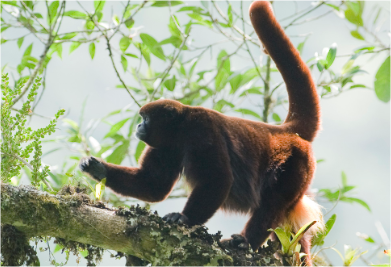
The yellow tailed woolly monkey is listed by the IUCN as “Critically Endangered” and, since the year 2000, has featured repeatedly on the list of the world’s top 25 most endangered primates. It is endemic to a small area of cloud forest in the Tropical Andes region of Peru. This area is known to be the most biodiverse region on earth.
The area faces immense pressures from mining concessions, commercial logging and land clearance for cattle ranching and coffee cultivation, and its forests are disappearing rapidly. NPC has published findings from a GIS survey of yellow tailed woolly monkey habitat in Peru, revealing alarming rates of deforestation and loss. It is estimated that at least 50% of the yellow tailed woolly monkey’s original habitat is already lost, and the remaining forest is under enormous threat.
Through scientific investigation, this project provides baseline information on the conservation status of L. flavicauda and other threatened species. Specific investigation work includes general animal and plant censuses and studies on the basic behavioural ecology, vocal communication and habitat requirements of L. Flavicauda,as well as studies on other threatened sympatric species, such as the endemic and little-known Andean night monkey (Aotus miconax). Our scientific achievements to date include the discovery of new populations of Lagothrix flavicauda; the first long-term behavioural study of L. flavicauda; and the first long-term density estimate for L. flavicauda. We have also conducted much needed studies on Aotus miconax and Callicebus oenanthe, and continue with further research for the conservation ecology of all three species. A second density estimate of primate populations, carried out in order to assess the impact of our conservation work, revealed an increase of ~30% in L. flavicauda density at our main research site. All of these studies can be accessed via the publications page.
We work with people from local communities who are interested in helping to create a network of community-run reserves for the conservation of the yellow-tailed wooly monkey and other species. To enable them to carry out effective conservation work, we work with them to create sustainable, eco-friendly income alternatives. Growing poverty and disastrous local climate changes have given many local people a first-hand appreciation of the urgent need to adjust to a more sustainable way of life, and are therefore more than willing to cooperate in any conservation effort.
The yellow tailed woolly monkey project combines the creation of community-run reserves with scientific census work within the proposed reserves, a reforestation program using native tree species that are beneficial to humans and wildlife, environmental education and the development of markets for native agriculture products, handicrafts made in the area, and sustainable ecotourism.
